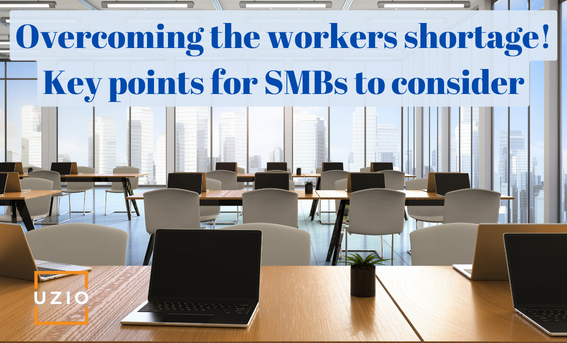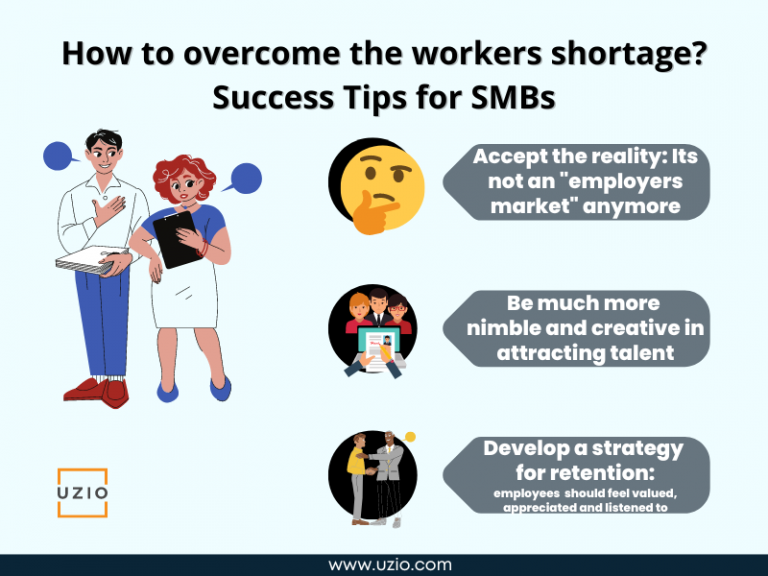
How to overcome the workers shortage? Key points for SMBs to consider.
Quick links
Introduction
We are witnessing the biggest talent crisis in recent history. “The Great Resignation” is underway. SMBs especially find themselves in uncharted territory. They are looking for help as they struggle to hire and retain employees. In this article, we will attempt to provide a template that SMBs can use to navigate through these troubled waters.
At the start of the year 2020, before Pandemic, the unemployment rate in the US was around 3.5%. When the Pandemic hit, we lost around 22 million jobs in the US. That’s around 14% of the total. Post Pandemic, with the opening up of the economy, we have recovered all of the lost jobs and, by July of this year, according to the US Labor Department, the overall labor market has more jobs than in February 2020.
While the overall job market has come back to pre-pandemic levels, there are certain sectors which have not recovered completely. State, local governments, schools, and the hospitality industry struggle to fill open positions. As children across the country are going back to school, the teacher shortages have reached crisis levels. The same is true in the restaurant industry where restaurateurs are cutting back on menu items as well as restaurant hours to be able to survive with the shortage of workers. Why are these sectors struggling to attract workers? Let us see if we can draw any parallels.
In the past, in a lot of low paying jobs, security of a regular paycheck was the main need of the employees. If you think of the Maslow’s Hierarchy of Needs, these employees were struggling at the lower two tiers and were not thinking about needs of esteem, recognition etc. which are higher up the Maslow Hierarchy. If the employer provided a regular paycheck, many employees plowed through even if the work environment was stressful or there was lack of recognition of their work or there were less opportunities to grow. Having a paying job was the most important factor. It was an “employers market” where employees had less leverage.
All that seems to have changed with the Pandemic. Now employees seem to have the leverage. Remote work has become a real option. Workers are demanding safe working conditions. Working in close quarters for long hours, like in a restaurant or a school, just seems risky to a lot of people. Plus there seems to have been a mind shift where employees are just not satisfied with a regular paycheck anymore. They expect more. They expect an engaged workplace where their voices are heard. They want to feel appreciated. They are looking for meaning in what they are doing. The reason employers across the country are struggling to fill the open positions is that they have not caught up with this new paradigm shift. They are operating under old rules.
What Can Employers Do To Attract Talent?
Employers should start by accepting the reality that it is not an “employers market” anymore. It is evident from the fact that hourly wages in many low skill industries have risen significantly since the pandemic.
Second, employers have to be much more nimble and creative in attracting talent. Wage increase, sign-on bonus, relocation allowance, relaxing hiring processes etc. should all be on the table.
Third, employers have to develop a strategy for retention. If your attrition is high, you will never win this race. To help with that, the most important thing employers can do is to create an engaged workplace. Employers should create a workplace where employees feel valued, appreciated and listened to.

Conclusion
Employers can turn the challenge of the shortage of employees into a strategic advantage by adopting the new paradigm. In the new paradigm, employers’ relationship with their employees is not transactional but strategic. Just providing a competitive salary will not be enough. Employers will have to invest in the growth of their employees and most importantly they will have to provide an engaged workplace.





